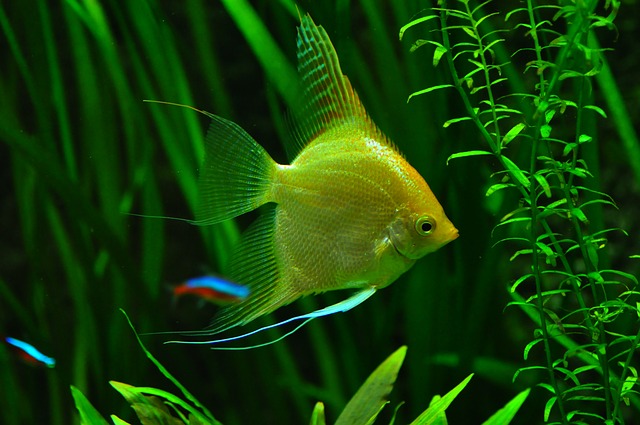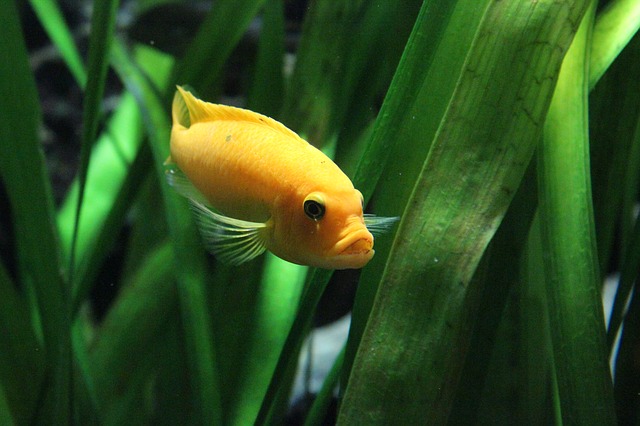
Whether to have plants in your aquarium is a matter of personal choice for many fish keepers. There are many great advantages of having plants in the aquarium. In this article I will talk about some of them and after reading them you may think of shifting to a planted aquarium by carefully studying all the factors that go into setting up and maintaining a planted tank.
Just like anything related to aquariums having a planted tank requires careful planning of lot of things, but the end results is simply awesome. Many fish keepers shift from a normal tank to a planted one just because it looks really amazing when finished.
Table of Contents
How can I shift from a non planted aquarium to a planted one?
If you currently have an aquarium without plants then in order to shift to a planted aquarium you must first study what is really needed so that plants grow and thrive in the environment. There needs to be changes made to your current setup that does not have plants and design and implement the changes in such a way that plant growth is a healthier one.
The most important factors to consider before you set up a planted tank.
1) Lighting set up required for planted tank
2) Carbon dioxide supply for plants
3) Fertilizers for plants
Let’s have a look at these very important factors one by one.
1) Lighting for plant growth–
In natural conditions sunlight is the main source of energy for all living beings including plants but in a closed environment artificial lighting can be used to help growth of plants. Scientifically speaking if your plants get less amount of light they will grow slowly and if you provide them more their growth will be faster.
The real challenge is to find out how much lighting you should provide above your aquarium because every plant has different capacities and requirements to absorb light. Some plants change color if you provide too much light above them. The simple rule you can follow here is to look for what power of lighting is being sold in the standard aquarium kits that you get at aquarium stores and provide them above your tank if your tank size matches to that of the tank size being sold in kits.
2) Carbon dioxide (CO2) for plant growth –
As general rule plants require light as well as CO2 to grow. Plants breathe carbon dioxide and exhale oxygen in return. the real challenge here is that if you provide extra lighting above your tank then they will grow faster but at the same time if you don’t provide enough CO2 with the lighting then it will be hard for the plants to cope with the breathing in the required CO2. for this to happen you must supply enough CO2 in the tank so that they can match up with the required growth rate.
However the neat thing about this is that if you don’t provide lighting above the tank the plants simply consume CO2 that is mixed in the water exhaled by the fish.
For tanks that are less than 20 gallons in capacity you can supply CO2 in supplement forms such as API Co2 Booster Freshwater Aquarium Plant Treatment 16 oz Bottle (paidlink) If you happen to use these in your tank for faster plan growth then you MUST read instructions and use very carefully as an extra dose of this can kill some fish.
3) Fertilizers for plant growth.
Apart from lights and CO2, plants also require nutrients for photosynthesis. For plants that have roots in the substrate their primary source of nutrients comes from substrate itself. Plants that float in the water column consume nutrients from the water column because water also contains some nutrients dissolved in it. Whether plants consume nutrients from substrate or from water column, are not sufficient for plant growth and this is where the need to supply nutrients through fertilizer arises. One easy way to supply fertilizers in the substrate is in the form of root tabs.
You’ll need these tabs only if the plants you chose have a heavy root system. Normally all the instructions and the frequency of using these is given on the packet by the manufacturer. One neat thing about this is that even if you do not plan a planted tank by adding these tabs you can convert a no planted tank into a planted one by adding extra nutrients in the substrate and let them handle all the plant growth.
But if you planning from scratch then you can definitely opt for nutrient rich substrate right from start so that you don’t need any external media to add nutrients in the substrate for plant growth. One cool thing about nutrient rich substrate is that they also contain beneficial bacteria that help in completing the “Nitrogen Cycle” faster.

Benefits of having plants in your aquarium
1) Oxygen can’t reach bottom of substrate and this is where anaerobic bacteria will give off hydrogen sulfide gas which is highly toxic. But this normally get tackled by dissolved oxygen in the tank water as it rises above from the bottom. Plant roots will open up gravel beds making it possible for oxygen to reach at bottom levels of the tank. Some CO2 is also present in the tank water which gets consumed by plants. Problem starts when you want the plants to grow faster by providing extra lighting. You must also supply extra CO2 to cater for the growth.
Plant roots help to hold down substrate in place that is used to create amazing landscapes such as hills or slopes as a decorating element.
2) Plants also consume nutrients from the gravel bed at the bottom. Solid waste that gets acculturated at the bottom of the gravel bed gets decayed and plants consume some of the nutrients for growth from there thus maintaining low levels of toxic gases.
However for plants that are floating and don’t have roots embedded in the substrate you’ll need some kind of fertilizer like “Easy Green”
One such example of the plant is hornwort
3) During photosynthesis plants absorb carbon dioxide CO2 and release oxygen O2. For non planted tanks this is achieved by adding an air pump and air stone to release forced air in the water that rises above and agitates water surface where mixing of air takes place. In case of a planted tank this happens easily during photosynthesis
4) Plants can provide hiding spaces for certain species or frays in case they are being attacked by bigger fish in the aquarium.
5) Plants absorb excess nutrients in your aquarium which if left un-absorbed will encourage algae growth in plants. By adding plants in your aquarium you eliminate the primary reason for algae growth.
6) Plants absorb most of the toxic gases in the aquarium water making it a live chemical and biological filter. This greatly reduces the maintenance cost and plus it looks awesome. You can certainly have a chemical filter but adding plants also adds beauty to your tank. Plants also provide extra surfaces for the beneficial bacteria to grow colonies that are responsible in the most important “Nitrogen Cycle”.
7) By having live plants you will require less water changes in your tank because most of the toxic gases will be absorbed by the plants keeping the nitrogen cycle intact.
8) From observation it has been seen that fish will interact with live plants more lively than with plastic artificial plants.
Are Planted aquariums hard to maintain?
Aquatic plants are not hard to maintain but it also depends on which species you choose in the first place. Some easy to grow plants for aquarium are Anubias, Krips, java fern, Jungle Val. These also require less light and display a beautiful show as well.
One of the key factors in picking up plants for aquarium is that to grow them healthy see to it that they require less light and don’t require much of carbon dioxide (CO2). With the plants mentioned above you will not have to spend money on special purpose expensive lighting system and all. Standard lights that come with any aquarium kit are sufficient to maintain the health of these plant species.
Another great advantage of picking up any of these starter plants is that they are quite hardy to water chemistry as well. Even if you mess up with water hardness a little sometime plant health will not get affected because these species can sustain the changes in hardness levels pretty easily. These plants will also sustain in pH levels of 6 -8 quite easily.
Another advantage of having starter plants that are easy to maintain is that you can get started by just a gravel bed as substrate. This is just the same gravel you can buy in any pet store and lay it at the bottom of the tank. This gravel will encourage plant growth without any special equipments or care.
As to maintain a planted tank all you have to do is provide a balance of lighting, CO2 and fertilizers in the correct quantity. If you increase any of these then you’ll also require increasing the other two also because plants will demand more of them to catch up with the faster growth.
For example if you provide too much lighting then the plants will grow faster demanding more CO2 and fertilizers. That is why don’t increase lighting just because it looks good from outside also think of all the other precautions you must provide to cater to this small change.
Can you add plants to an established aquarium?
Yes you can definitely add plants to an established tank that has been cycled already. To add plants you must first check which species you are buying and how much light they require for normal growth.
When you buy then from the store you can take pictures of your current set up like wattage of light you want to install and the type of substrate you are having currently in your tank.
Some plants require a nutrient rich substrate for growth, but even if you don’t have that right now you can insert root tabs for that and get along with a non-nutrient rich substrate. As far as lighting s concerned you can start with a standard lighting kit and observe their effect on plants. Start with a few easy to grow species and then consider adding more.
How long do aquarium plants live?
When you have a planted tank they do not normally die. Most aquatic plants live for longer years and will keep on producing amazing display for your tank and keep the cleaning process for years to come.
The only requirement is that just like fish you must look after the plants and all of their requirements almost everyday. Plants require 3 things to keep thriving in your tank.
1) Enough light
2) Carbon dioxide for breathing
3) Nutrients through fertilization.
As long as you are providing these things plants do not die in an aquarium. Many people who have aquariums that are as old as 25 years and the plants that they planted while starting are still thriving in the tank. SO all it takes is to understand the basics and keep caring for them. These aquarium plants will serve you for years to come happily.